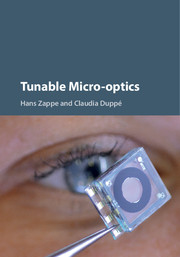Book contents
- Frontmatter
- Dedication
- Contents
- List of contributors
- List of acronyms
- Part I Introduction
- Part II Devices and materials
- 3 Soft-Matter Micro-optics
- 4 Tunable Reflective Optics
- 5 Tunable Liquid Lenses
- 6 Optofluidic Micro-shutters and Micro-irises
- 7 Solid Body Elastomeric Lenses
- 8 Spatially Tunable Polarization Devices
- 9 Aluminum Nitride and Diamond Membranes for Tunable Micro-optics
- 10 Piezoelectrically Actuated Tunable Microlenses
- Part III Systems and Applications
- Index
- References
4 - Tunable Reflective Optics
from Part II - Devices and materials
Published online by Cambridge University Press: 05 December 2015
- Frontmatter
- Dedication
- Contents
- List of contributors
- List of acronyms
- Part I Introduction
- Part II Devices and materials
- 3 Soft-Matter Micro-optics
- 4 Tunable Reflective Optics
- 5 Tunable Liquid Lenses
- 6 Optofluidic Micro-shutters and Micro-irises
- 7 Solid Body Elastomeric Lenses
- 8 Spatially Tunable Polarization Devices
- 9 Aluminum Nitride and Diamond Membranes for Tunable Micro-optics
- 10 Piezoelectrically Actuated Tunable Microlenses
- Part III Systems and Applications
- Index
- References
Summary
Introduction
Reflective optics (plane and curved mirrors, gratings, etc.) modify the wavefront of a reflected light beam. Tunable reflective optics bring that wavefront modification under system control. For example, a spherical mirror for which the radius of curvature can be adjusted will have a tunable focal length. A mirror with flexible control of higher-order surface corrugation might compensate aberration to clear up a blurry image. Already, we find tunable reflective optics playing a critical role in barcode and three-dimensional (3D) scanners, compact laser displays, full screen theater projectors, tiny optical fiber modulators, and tunable laser sources, to mention but a few applications. As performance and sophistication continue to increase and costs decrease, we will likely see entirely new capabilities enabled by these remarkable active optical elements.
For some uses, reflective optics might be used interchangeably with transmissive optics. But often there are reasons one may prefer a reflective optic over a transmissive one, or vice versa. For example, for very large apertures such as the primary lens on an astronomical telescope, mirrors are preferred when the sheer weight of a large glass lens becomes unmanageable. Reflective optics also exhibit very low chromatic aberration, helping them to perform well over a broad spectral range. On the other hand, reflective systems offer unique challenges related to obscuration of the optical path, sometimes necessitating the use of beam splitters or divided pupils to get the beam in and out of the system.
There are further characteristics that are important when considering reflection or transmission for tunable optics. One is the possibility of using a large number of actuators, which in the case of a reflective optic can be hidden behind the mirror where they won't interfere with the optical beam. Such mirrors offer precise control over the shape of the optical surface and can form the basis of an aberration compensation mirror, a precise aspheric lens, or a tunable grating. Another feature of reflective optics is the extremely light weight of the movable element, which is often a thin membrane. This optical surface can consequently be moved quickly, leading to very short response times compared to tunable transmissive optics based on redistributing volumes of liquid that are heavier and can cause viscous drag. A third difference is the magnitude of surface motion required to create a particular wavefront sag.
- Type
- Chapter
- Information
- Tunable Micro-optics , pp. 92 - 122Publisher: Cambridge University PressPrint publication year: 2015

